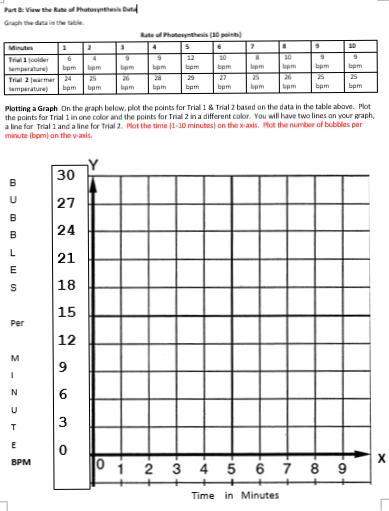10. keep your settings from #9c (25°c, light intensity of 20, increased co2).
a. what w...

Biology, 05.11.2019 12:31 charati1317
10. keep your settings from #9c (25°c, light intensity of 20, increased co2).
a. what were the bubbles per minute in this setting? bpm
b. now increase the temperature to 40°c. what were your bubbles per minute?
c. based on your data, how does an increase in temperature affect the rate of photosynthesis? (it might to complete #11 before you answer this question.)
the increase in temperature slowed down the rate of photosynthesis.
11. return to your settings from #9c (25°c, light intensity of 20, increased co2).
a. what were the bubbles per minute in this setting?
b. now decrease the temperature to 10°c. what were your bubbles per minute? ++bpm
c. based on your data, how does a decrease in temperature affect the rate of photosynthesis?
12. alter the variables in order to determine which combination leads to the highest rate of photosynthesis.
which combination of settings produced the highest number of bubbles per minute?
a. temperature:
b. light:
c. co2:
how many bubbles per minute did you count for this setting?
13. looking back at your hypothesis from question 8, does your data support your hypothesis? why or why not? (for full credit write two complete sentences.)


Answers: 1


Another question on Biology

Biology, 22.06.2019 09:30
The ruiz family is exchanging euros for us dollars. the exchange rate is 1 euro equals 1.35261 usd. since the ruiz family knows that usd are stated to the nearest hundredth of a dollar, they used the conversion ratio
Answers: 1

Biology, 22.06.2019 10:30
Ras is a g-protein that is activated when a growth factor attaches to egfr. its activation results in the replacement of a gdp molecule with a gtp molecule, thus allowing a signal transduction pathway to be activated. considering the signal pathway illustrated on this page, what is one potential outcome of a mutation in the ras gene that leads to ras protein hyperactivity. be specific.
Answers: 3

Biology, 22.06.2019 13:00
Dna, in the nucleus carries the genetic code for making proteins in ribosomes. in the diagram, b, represents the proteins produced. dna cannot leave the nucleus to carry the genetic information to the ribosome where proteins are produced. how does the genetic code get from the nucleus to the ribosome? what does a represent? now
Answers: 1

Biology, 22.06.2019 14:20
As scientist had investigated evolution from a variety fields they have found
Answers: 2
You know the right answer?
Questions


Mathematics, 30.01.2022 14:50

Mathematics, 30.01.2022 14:50

Mathematics, 30.01.2022 14:50


Mathematics, 30.01.2022 14:50

Biology, 30.01.2022 14:50

English, 30.01.2022 14:50


Mathematics, 30.01.2022 15:00


English, 30.01.2022 15:00

Mathematics, 30.01.2022 15:00



English, 30.01.2022 15:00

History, 30.01.2022 15:00

Physics, 30.01.2022 15:00

English, 30.01.2022 15:00



